Environmental factors play a role in the development of endometriosis
Dec 13, 2021
Understanding the role of environmental factors in endometriosis development will contribute to both the prevention and treatment of the disease.
Key Points
Highlights:
- Due to its heterogeneity and diagnostic difficulty, it is hard to determine the exact role of environmental factors in the development of endometriosis.
Importance:
- Environmental factors that pose a risk for endometriosis growth are important for both the woman herself and her daughters.
What’s done here?
- This review evaluates the effect of environmental factors on the development of endometriosis.
- The recent data were collected from the literature to discuss their possible role in endometriosis development.
- Dioxins, polychlorinated biphenyls, estrogens, diet, endocrine-disrupting chemicals, bisphenol A, and environmental factors were reviewed for their possible relation.
Key results:
- When evaluating the relationship between endometriosis development and environmental factors, it should be noted that there is no reasonable consistency in the literature.
- Female fetuses are susceptible to intrauterine exposure of diethylstilbesterol (DES) in terms of endometriosis development which is a drug used to prevent premature birth. In addition, exposure to DES during pregnancy results in uterine structural abnormalities and interferes with the expression of estrogen receptors in female fetuses, which are accepted as risk factors for endometriosis.
- Exposure of women to toxins such as 2,3,7,8-tetrachlorodibenzodioxin (TCDD), bisphenol, and other dioxins may pose a higher risk of endometriosis in their daughters depending on epigenetic changes.
- Nicotine, along with its metabolite cotinine, in smoking pregnant women can decrease the risk of endometriosis in female fetuses due to suppression of aromatase, stimulation of apoptosis, and inhibition of angiogenesis.
- Although there is an unclear association between dietary habits and endometriosis development, women who have a diet rich in red meat are at higher risk for the disease. Because pro-/antioxidant balance is disturbed and the hormone level increases in favor of estrogen
- The endocrine-disrupting chemicals (EDC), exogenous chemicals, or a mixture of chemicals interfering with any aspect of hormone action, are found in cosmetics and personal care products and have estrogenic and pro-oxidative effects resulting in an increased risk of endometriosis development. Of those, dioxin which persists in the environment for a long time is found to be high in women with endometriosis.
Lay Summary
The proposed mechanisms underlying the development of endometriosis may be classified into three groups: in-situ theory, implantation theories, and induction theories. Genetic, hormonal, environmental, and lifestyle-related factors are also involved as no mechanism is solely responsible for endometriosis development. Although there are several papers in the literature about the effect of ecological factors on endometriosis development, contradictory conclusions are encountered.
Polak et al. from Poland published a review titled “Environmental Factors and Endometriosis” in the journal named "International Journal of Environmental Research and Public Health".
The authors aimed to evaluate the association between environmental factors and endometriosis development. The impact of dioxins, polychlorinated biphenyls, estrogens, diet, endocrine-disrupting chemicals, bisphenol A, and some other environmental factors on endometriosis development was discussed. Additionally, the importance of intrauterine exposure to some chemicals for the development of endometriosis was emphasized.
However, it is difficult to determine the exact role of environmental factors in endometriosis development due to the heterogeneous nature of the disease. It is also difficult to quantify exposure to chemicals and to design a study in which the study and control groups are standardized. The environmental factors accepted as the most responsible for endometriosis development were found to be endocrine-disrupting chemicals, 2,3,7,8-tetrachlorodibenzodioxin (TCDD), bisphenol, dioxin, intrauterine exposure of diethylstilbesterol, and dietary habits rich in red meat.
“It is also impossible to determine the exact onset of the condition. In addition, due to the polyetiological and still unclear nature of endometriosis, it is impossible to eliminate the impact of other factors involved in its pathogenesis, which is why the results of individual studies may greatly differ, making it very difficult to draw any definite conclusions,” they concluded.
Research Source: https://pubmed.ncbi.nlm.nih.gov/34769544/
endometriosis environmental factors diet endocrine-disrupting chemicals diethylstilbesterol dioxin red meat 2 3 7 8-tetrachlorodibenzodioxin nicotine

